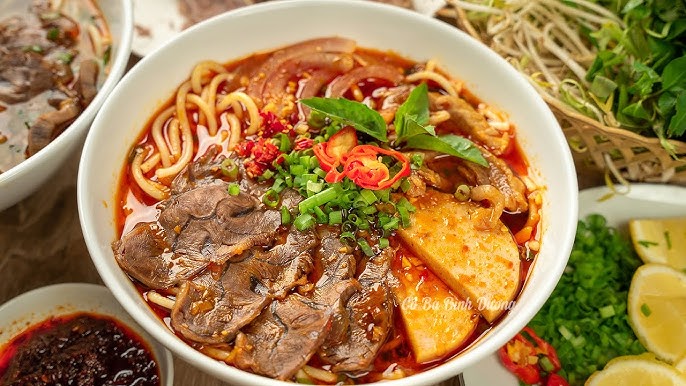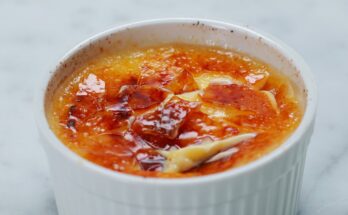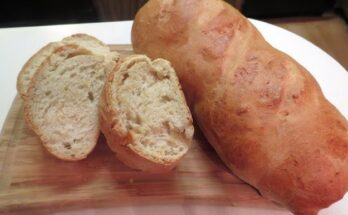Bún Bò Huế Recipe: Bún Bò Huế is a spicy Vietnamese noodle soup that originates from the city of Huế in central Vietnam. Unlike its more internationally known cousin, Phở, Bún Bò Huế delivers a bold, spicy, and deeply savory flavor that is both unique and unforgettable. The name breaks down as follows: Bún refers to the rice vermicelli noodles, Bò means beef, and Huế refers to the city of its origin.
This dish is renowned for its balance of spicy, salty, and umami notes, typically served with thick rice noodles, tender slices of beef, pork knuckles, and sometimes even congealed pork blood for authenticity. What sets it apart is the aromatic broth made with lemongrass and chili oil, creating a flavor explosion in every spoonful.
Origin and Cultural Significance
Huế was once the imperial capital of Vietnam, and its cuisine reflects the sophistication of royal cooking. Bún Bò Huế is a legacy of that heritage. It’s not just a meal; it’s a symbol of cultural pride for central Vietnam. Traditionally enjoyed for breakfast, it’s hearty enough to be eaten at any time of day.
The dish holds a special place in Vietnamese cuisine. Families pass down recipes through generations, each adding their twist while maintaining the dish’s core integrity. It’s not uncommon to find regional variations, but the soul of Bún Bò Huế remains the same — spicy, fragrant, and deeply comforting.
Ingredients You’ll Need
For the Broth
Creating an authentic Bún Bò Huế starts with a robust broth. Here’s what you’ll need:
- 2 lbs beef shank (cut into chunks)
- 1 lb pork hock or pork knuckles
- 1 stalk lemongrass (bruised and cut into sections)
- 1 medium onion (charred)
- 1 thumb-sized piece of ginger (charred)
- 2 tbsp fish sauce
- Salt and sugar to taste
- 1 cube of fermented shrimp paste (mắm ruốc)
- 10 cups water
These ingredients are the foundation of the soup’s intense, savory flavor. The combination of beef and pork lends a richer mouthfeel, while lemongrass and shrimp paste add that unmistakable depth and aroma.
For the Noodles and Toppings
You’ll also need ingredients for the body of the soup — the noodles and toppings that complete the dish:
- 1 package thick rice vermicelli noodles (Bún)
- Thinly sliced beef brisket or flank
- Vietnamese pork sausage (Chả lụa)
- Cubed pork blood (optional but traditional)
Properly prepared noodles and meats are essential for that authentic texture and bite. The toppings give every bowl a visual and culinary boost.
Optional Garnishes
No bowl of Bún Bò Huế is complete without fresh, crunchy, and aromatic garnishes:
- Bean sprouts
- Lime wedges
- Thinly sliced banana blossoms
- Fresh herbs (cilantro, mint, Thai basil)
- Shredded cabbage
- Sliced green onions and white onions
These garnishes don’t just add a pop of color—they enhance the flavor profile, adding brightness, texture, and balance to the bold broth.
Preparing the Broth
Choosing the Right Cuts of Meat
The base of a great Bún Bò Huế lies in selecting the right cuts of meat. Beef shank provides a rich flavor and soft texture when slow-cooked, while pork hock adds a gelatinous, savory dimension. Some people even toss in bones for a deeper umami punch. The bones, when simmered for hours, release collagen, enriching the broth with both flavor and body.
Don’t rush the meat selection process. Look for fresh, well-marbled cuts. If you can, ask your butcher for specific recommendations for soup bases.
Boiling and Skimming the Broth
Start by parboiling the beef and pork in boiling water for 5 minutes. This helps remove impurities and results in a clearer broth. Drain, rinse, and add the meat back to a clean pot with 10 cups of fresh water. Bring to a gentle boil.
Skim off the foam and scum that rises to the surface. This step is crucial for a clear, clean-tasting broth. Add the lemongrass, charred onion, and ginger at this stage. Simmer uncovered for 2-3 hours. The longer, the better — just make sure to maintain a gentle simmer to avoid cloudiness.
Adding Spices and Aromatics
Now comes the seasoning. Stir in fish sauce, a touch of sugar, salt, and the crucial fermented shrimp paste. Don’t skip the mắm ruốc — it’s the secret behind the soup’s complexity. Simmer for another 30 minutes to let the flavors meld together.
Your kitchen will smell incredible at this point — earthy, spicy, and tangy all at once. Taste and adjust your seasonings as needed.
Making the Lemongrass Chili Oil
Ingredients for Chili Oil
The lemongrass chili oil is the signature touch that defines Bún Bò Huế. It delivers that fiery punch and aromatic fragrance that lingers in your memory long after the last slurp. Here’s what you need:
- 4 tablespoons of neutral oil (vegetable or canola)
- 2 stalks of lemongrass (finely minced)
- 1 tablespoon chili flakes (adjust to your spice tolerance)
- 1 teaspoon paprika (for color)
- 2 cloves garlic (minced)
- 1 small shallot (finely chopped)
This combination creates a beautiful, deep red oil that sits on top of the broth, signaling the intensity of flavor underneath. Make sure your ingredients are finely chopped to avoid burning during cooking.
Cooking the Oil to Perfection
Start by heating the oil in a small saucepan over medium heat. Add garlic and shallots first, stirring constantly to avoid browning them too fast. Once they turn slightly golden, toss in the minced lemongrass. Continue stirring until the mixture becomes fragrant, usually around 2-3 minutes.
Add the chili flakes and paprika last. The paprika enhances the red hue, while the chili brings the heat. Reduce the heat to low and simmer the mixture for another 2-3 minutes, stirring continuously.
Once done, turn off the heat and let the oil cool. This spicy lemongrass chili oil can be stored in a glass jar for later use — and it’s also excellent drizzled over other Vietnamese dishes!
Cooking and Assembling the Noodles
Cooking Rice Noodles Properly
The rice noodles used in Bún Bò Huế are thicker than the ones used in Phở, giving the dish a satisfying chew. These noodles need to be cooked just right — too soft and they’ll fall apart in the broth; too firm and they’ll overpower the dish.
Bring a large pot of water to a rolling boil. Add the rice noodles and cook according to the package directions, typically around 10–15 minutes. Stir occasionally to prevent sticking.
Once cooked, immediately rinse the noodles under cold running water to stop the cooking process and remove excess starch. Drain well and set aside. This step helps maintain their chewy texture when the hot broth is poured over them.
Slicing Meats and Preparing Toppings
While your broth is simmering and noodles are resting, it’s time to prep the meats. Thinly slice the cooked beef shank and brisket. If using pork hocks, separate the meat from the bones for easy eating. Vietnamese pork sausage (Chả lụa) should be sliced into bite-sized pieces.
If you’re including pork blood cubes, blanch them in hot water until firm and set aside.
Prepare the fresh garnishes: thinly slice banana blossoms, shred the cabbage, rinse the bean sprouts, and chop fresh herbs. Arrange everything neatly for easy access during assembly.
Assembling the Bowl
Layering Ingredients
This is the fun part — putting it all together. Start by placing a generous heap of rice noodles into a large soup bowl. Then layer in slices of beef, pork sausage, and any additional meats you’ve prepared.
Don’t overcrowd the bowl. The beauty of Bún Bò Huế is in its elegant composition, where every element has its place.
Add your garnishes: a handful of bean sprouts, some shredded banana blossoms, a few sprigs of Thai basil or mint, and thinly sliced onions. Fresh herbs go a long way in balancing the bold broth.
Pouring the Broth Just Right
Now, the moment of truth — ladling the steaming hot broth over your perfectly arranged bowl. Make sure you scoop a bit of everything: meat, broth, and lemongrass. Top it off with a generous spoonful of your homemade lemongrass chili oil.
You’ll notice the vibrant red sheen from the oil floating atop the broth. It’s not just for looks — it’s your flavor bomb. Squeeze in a lime wedge and give the bowl a gentle stir.
And there it is: a steaming, aromatic, deeply flavorful bowl of Bún Bò Huế that’s ready to knock your socks off.
Tips for Authentic Flavor
Achieving the Signature Spicy Kick
If there’s one thing Bún Bò Huế is known for, it’s that delightful kick of heat. Getting that signature spice level right is a matter of balance—not just setting your mouth on fire. Here’s how to nail it:
Use a combination of fresh and dried chili. The dried chili flakes provide a base level of heat, while fresh chilies bring sharp, bright spice. The chili oil, prepared earlier, adds layers of warmth and fragrance.
Fermented shrimp paste also intensifies the flavor without necessarily upping the heat. It gives the broth a complexity that mimics the heat’s depth. Want more spice? You can always add sliced Thai chili on the side to let each eater adjust the heat.
The key is not to go overboard at first—let the rich broth, meats, and noodles shine. Then build up your spice level through garnishes or additional chili oil as desired.
Balancing Sweet, Salty, and Umami
One of the most overlooked parts of making Bún Bò Huế at home is flavor balance. A truly authentic version doesn’t just taste spicy—it dances between sweet, salty, and savory (umami) perfectly.
Here’s how you do it:
- Sweet: A pinch of sugar helps bring out the natural sweetness of the broth. Don’t skip this; it’s not to make it sugary but to round out the flavor.
- Salty: Fish sauce is your best friend here. Add it in small increments and taste as you go.
- Umami: The slow-simmered bones and the fermented shrimp paste create an umami bomb that lingers in the mouth.
Remember, the goal isn’t to make the broth taste like any one of these elements individually but to combine them so smoothly that you get a harmonious bite every time.
Common Mistakes to Avoid
Cooking Bún Bò Huế isn’t rocket science, but a few missteps can dull its vibrant flavor. Let’s look at the most common mistakes and how to dodge them:
- Using low-quality broth base: The richness of this soup comes from hours of simmering bones and meat. Skipping this or rushing it with store-bought stock will leave your dish tasting flat.
- Forgetting to skim the broth: Fat and scum on the surface of the broth make it cloudy and heavy. Keep it light and clear by regularly skimming.
- Overcooking the noodles: Rice noodles go from perfect to mushy fast. Stick to the package instructions and rinse them well after boiling.
- Over-seasoning early: The flavors in Bún Bò Huế develop over time. It’s better to under-season initially and adjust later than to go overboard.
- Not charring the aromatics: Charring the onion and ginger adds a rich, smoky depth to the broth. It’s a small step that makes a big difference.
Avoid these slip-ups, and you’re already halfway to a restaurant-worthy bowl of Bún Bò Huế.
Variations of Bún Bò Huế
As with most traditional dishes, there are numerous ways to make Bún Bò Huế, especially depending on the region or even household. Some variations include:
- Bún Bò Giò Heo: Focuses more on pork hock than beef, delivering a more gelatinous and rich broth.
- Bún Bò Huế Chay (Vegetarian): Made with tofu, mushrooms, and vegetarian broth. Surprisingly delicious when done right, with lemongrass and chili oil still taking center stage.
- Bún Bò Huế with Seafood: In coastal regions, you might find versions that incorporate squid, shrimp, or fish balls. These variations still follow the basic seasoning rules but add a sea-sweet twist.
- Instant Bún Bò Huế Packs: While not the same as homemade, some brands offer decent approximations with dried noodles and seasoning packets.
Don’t be afraid to get creative once you’ve mastered the traditional form. Just keep the core flavor profile in mind, and you can add your own twist.
Serving Suggestions
Presentation matters, especially for a dish as visually appealing as Bún Bò Huế. Here are some ways to elevate your serving:
- Use large, deep bowls so you can showcase the noodles, meats, and garnishes properly.
- Serve with lime wedges, chili sauce, and extra herbs on the side so guests can customize their bowls.
- Add a crispy baguette or side of spring rolls to round out the meal.
- Consider offering iced jasmine tea or Vietnamese iced coffee to balance the heat.
The beauty of Bún Bò Huế lies in its harmony. Pair it with side dishes and beverages that complement its bold, spicy essence rather than overpower it.
Health Benefits of Bún Bò Huế
At first glance, Bún Bò Huế might seem like just another indulgent comfort food. But look a little closer, and you’ll discover it’s packed with health benefits — especially when made at home with fresh ingredients.
Rich in Protein and Collagen
With a base of beef shank and pork hock, this soup is a solid source of high-quality protein. Protein supports muscle repair and overall energy. Pork hocks, when simmered for hours, release collagen into the broth — great for joint health, skin elasticity, and even digestion.
Lemongrass and Spices Aid Digestion
Lemongrass isn’t just a flavor enhancer; it’s also known for its digestive and anti-inflammatory properties. Combined with chili, garlic, and ginger, the broth becomes a natural immunity booster and can help in clearing sinuses and improving circulation.
Low in Processed Ingredients
When you make it yourself, Bún Bò Huế is surprisingly clean. No MSG, no preservatives — just bones, herbs, spices, and rice noodles. It’s naturally gluten-free and can be adjusted to suit specific dietary needs (low-sodium, low-fat, etc.).
Customizable for Dietary Preferences
Don’t eat red meat? Replace beef with chicken or seafood. Going vegetarian? Swap meat for tofu and mushrooms while keeping the same rich spice profile. The flexibility of this dish makes it accessible to a variety of health-conscious diets.
So yes, Bún Bò Huế is comforting, hearty, and delicious — but it’s also loaded with nutrients and body-nourishing ingredients when made right.
Storage and Reheating Tips
Let’s be honest — as good as Bún Bò Huế is fresh, it might be even better the next day. The flavors deepen and meld together, creating an even richer experience. But to enjoy it again, you need to store and reheat it properly.
How to Store
- Broth: Store the broth separately from the noodles and toppings. Pour it into an airtight container and refrigerate for up to 4 days. Freeze for longer storage — up to 3 months.
- Noodles: Rinse cooked noodles with cold water, toss them in a bit of oil to prevent sticking, and keep them in a sealed container in the fridge for up to 3 days.
- Toppings: Store garnishes like herbs and sprouts in separate containers with a paper towel to absorb moisture.
How to Reheat
- Broth: Reheat gently on the stove over medium heat until simmering. If it’s been frozen, defrost overnight in the fridge first.
- Noodles: Dip briefly in hot water or microwave with a splash of water to soften.
- Assembly: Reassemble as you would with a fresh bowl — noodles first, then meat, then steaming broth, and finish with garnishes.
Never reheat Bún Bò Huế by microwaving it all at once. It ruins the textures and muddles the flavors. Separate heating = the best next-day taste.
FAQs about Bún Bò Huế Recipe
1. Can I make Bún Bò Huế vegetarian?
Absolutely! Substitute meat with tofu and use mushroom or vegetable broth. Don’t forget to keep the lemongrass and chili oil — they’re key to the flavor.
2. Is Bún Bò Huế gluten-free?
Yes, traditionally it is. The rice noodles are gluten-free, and if you use gluten-free fish sauce, you’re all set.
3. How spicy is Bún Bò Huế supposed to be?
It’s meant to have a noticeable kick, but not unbearable heat. You can control the spice level by adjusting the amount of chili oil and fresh chilies.
4. Can I freeze Bún Bò Huế?
Yes, the broth freezes very well. Just store it separately from noodles and toppings. Defrost and reheat gently for best results.
5. What if I can’t find lemongrass?
Lemongrass is essential to the flavor, but if you’re in a pinch, you can use lemongrass paste or dried lemongrass. Fresh is best, though.
Final Thoughts
Bún Bò Huế isn’t just a bowl of noodle soup — it’s a culinary journey that tells a story with every slurp. From the imperial kitchens of Huế to your dining table, it brings a piece of Vietnamese heritage to life.
Whether you’re new to Vietnamese cuisine or a seasoned foodie, this dish deserves a place in your kitchen. It’s spicy, soulful, and endlessly customizable. Mastering Bún Bò Huế at home might take a bit of effort, but trust me — every step is worth it. From the deep, aromatic broth to the vibrant toppings, it’s a bowl that truly satisfies all the senses.
So, grab your chopsticks and a spoon. It’s time to bring a taste of Huế into your home.



